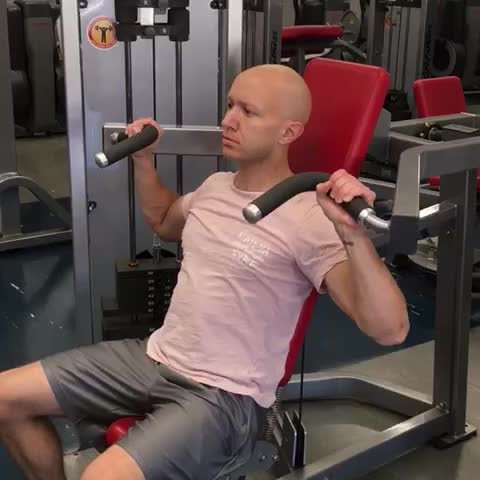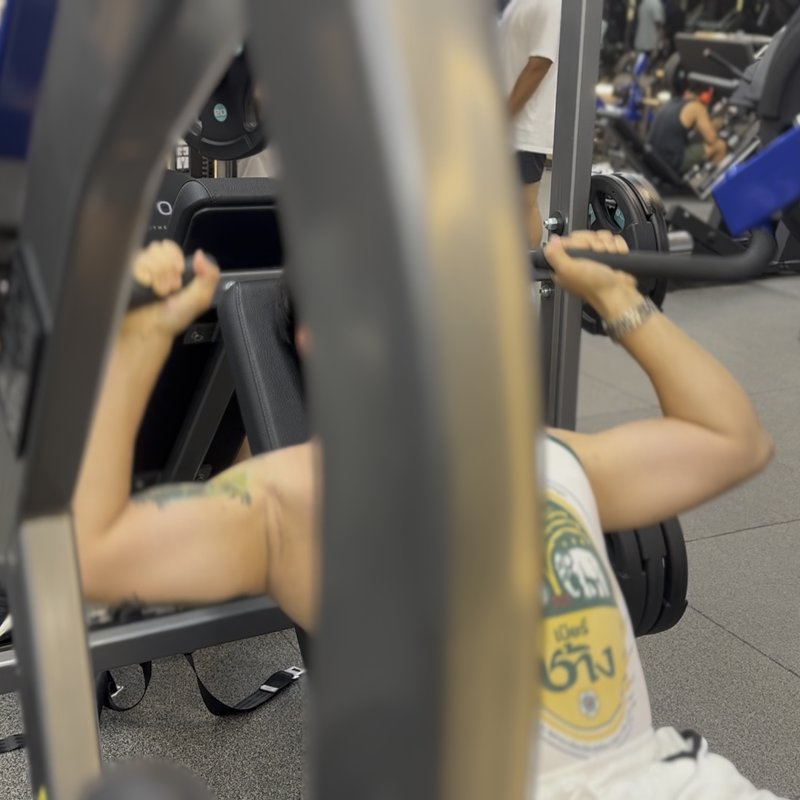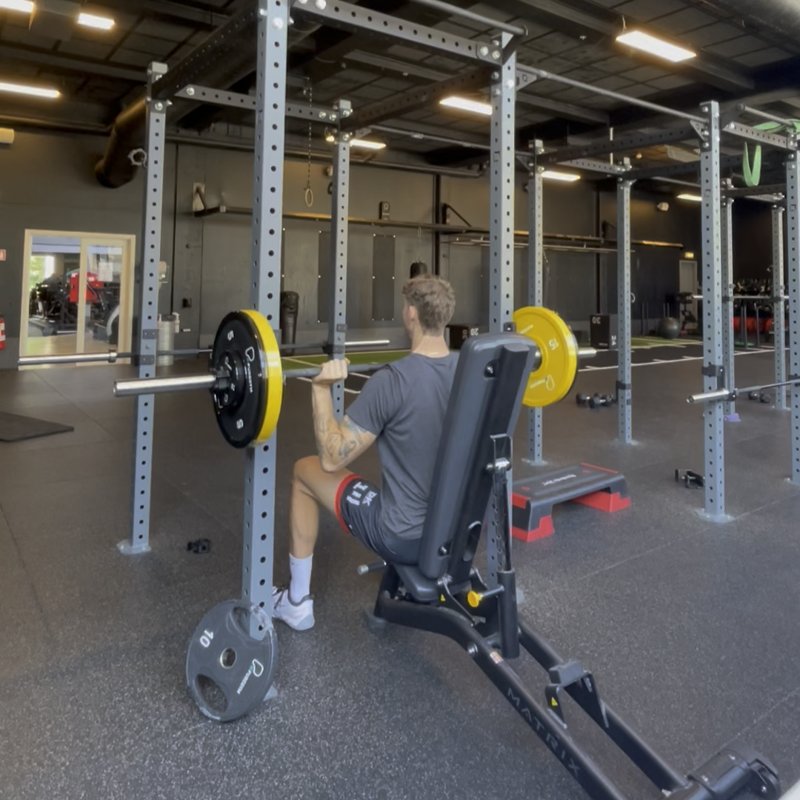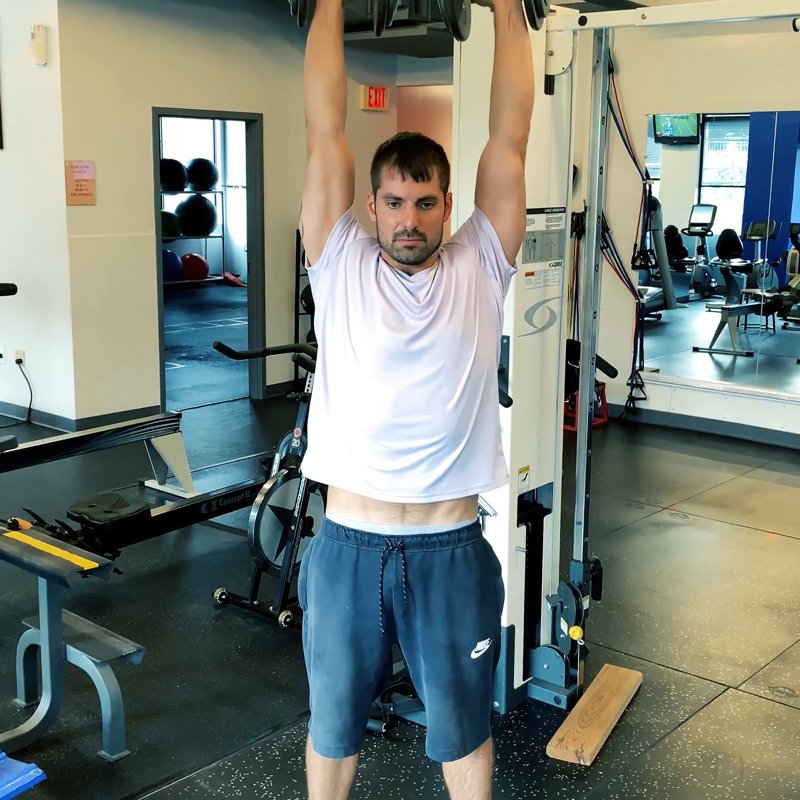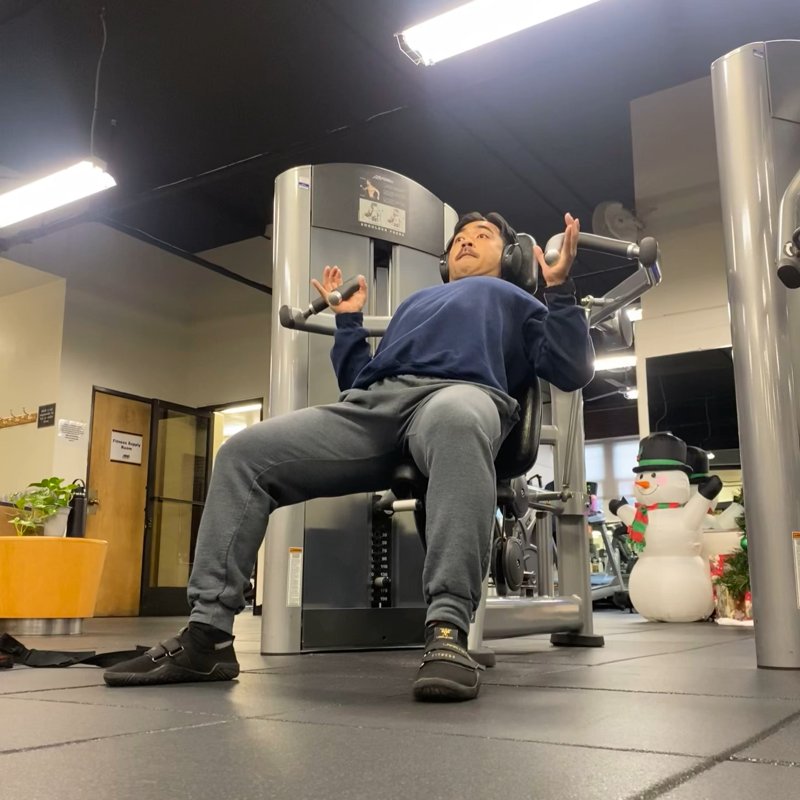Smith Machine Shoulder Press: The Ultimate Guide
The Smith Machine Shoulder Press is a compound upper body exercise that primarily targets the deltoid muscles while providing a fixed bar path for stability and controlled movement patterns.
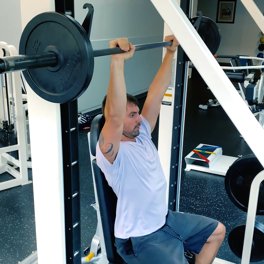
Quick Facts
Key Benefit
Shoulder strength and development with reduced stabilization demands
Primary Muscles
Anterior Deltoids, Medial Deltoids, Triceps
Secondary Muscles
Abdominals, Pectoralis Major, Pectoralis Minor, Posterior Deltoids, Traps
Equipment
smith machine, incline bench (optional)
Difficulty
Beginner
Type
Compound
In This Guide
Ready to master the Smith Machine Shoulder Press?
Track your progress, see improvements over time, and build strength consistently.
Download GravitusThe Smith Machine Shoulder Press is a valuable variation of the traditional overhead press that offers unique benefits for shoulder development. This exercise primarily targets the deltoid muscles—the rounded muscles that cap the shoulders—while also engaging the triceps, upper chest, and core stabilizers. What distinguishes the Smith Machine version from free-weight alternatives is the fixed vertical bar path, which reduces the need for stabilization and allows for focused attention on the primary pushing muscles. This makes it particularly beneficial for beginners learning proper pressing mechanics, those rehabilitating from certain injuries, or experienced lifters looking to isolate specific muscles without the balance demands of free weights. The guided motion also enables safe training to muscular failure without spotters and allows for various grip positions and setup arrangements that might be challenging with free weights. While purists may prefer barbell or dumbbell overhead presses for their greater stabilizer recruitment, the Smith Machine variation offers distinct advantages for hypertrophy-focused training and certain training scenarios. Whether your goal is building shoulder size, improving pressing strength, or adding variety to your upper body training, the Smith Machine Shoulder Press provides an effective, controlled environment to develop the muscles that contribute significantly to an aesthetic and functional upper body.
Benefits of Smith Machine Shoulder Press
The Smith Machine Shoulder Press offers several distinct advantages that make it a valuable addition to shoulder training routines.
Reduced Stabilization Requirements
The guided bar path decreases the need for balance and extensive stabilizer recruitment, allowing greater focus on the primary deltoid muscles.
Safety and Confidence
The ability to hook the bar at any point during the movement enables safe training to failure and builds confidence for those new to overhead pressing.
Isolation and Mind-Muscle Connection
With less focus needed for stabilization, you can direct more attention to feeling the target muscles work throughout the movement.
Variety of Positions
The Smith Machine allows for both seated and standing variations, as well as presses performed in front of or behind the head with different grip widths.
Progressive Overload Potential
The stability provided by the machine often enables lifters to use heavier weights than with free-weight variations, facilitating progressive overload.
Proper Form & Technique
Setup
- Position an adjustable bench in the Smith Machine if performing seated (or stand facing the bar for a standing variation).
- Adjust the bench and bar height so that when seated, the bar rests approximately at upper chest level.
- Set the seat position so your eyes align roughly with the bar when it's at the bottom position.
- Sit on the bench with your feet flat on the floor, back straight, and core engaged (or stand with feet shoulder-width apart).
- Grasp the bar with a pronated grip (palms facing forward) at a width slightly wider than shoulder-width.
- Unlock the bar from the safety hooks and lower it to the starting position at your upper chest/shoulder level.
Movement
- Begin with the bar at upper chest level, elbows below the bar and pointed down and slightly forward.
- Brace your core and maintain a neutral spine position throughout the movement.
- Exhale as you press the bar upward in a controlled manner, following the fixed vertical path of the Smith Machine.
- Continue pressing until your arms are fully extended overhead, without locking out the elbows completely.
- At the top position, the bar should be aligned over your shoulders or slightly behind them for optimal shoulder engagement.
- Pause briefly at the top position to enhance mind-muscle connection.
- Inhale as you slowly lower the bar back to the starting position at your upper chest, controlling the descent.
- Repeat for the desired number of repetitions or until reaching temporary muscular failure.
- Re-rack the bar on the safety hooks when the set is complete.
Key Form Tips
Head Position
Keep your head in a neutral position or slightly tucked throughout the movement to maintain proper cervical spine alignment.
Core Engagement
Maintain a braced core to protect your lower back, especially when performing the standing variation.
Bar Path
While the Smith Machine guides the motion, focus on pressing slightly backward at the top for optimal deltoid recruitment.
Elbow Position
Keep elbows at approximately a 45-degree angle from your torso at the bottom position to minimize shoulder stress.
Range of Motion
Lower the bar to your upper chest/clavicle area and press until arms are extended but not completely locked out.
Muscles Worked
Primary Muscles
- anterior deltoids: The front portion of the shoulder muscle is the primary mover in this exercise, responsible for the initial push and shoulder flexion.
- medial deltoids: The middle head of the deltoid contributes significantly to the movement, particularly as the bar passes the midpoint of the press.
- triceps: The three-headed muscle at the back of the upper arm works to extend the elbow during the pressing motion.
Secondary Muscles
- pectoralis major: The upper portion of the chest muscle assists during the initial phase of the press, particularly with a grip width closer to shoulder width.
- posterior deltoids: The rear head of the shoulder provides stabilization and assists slightly during the lockout phase of the movement.
- traps: The upper and middle fibers of this large back muscle work to stabilize the shoulder blades during the overhead press.
- pectoralis minor: This muscle along the ribs assists with shoulder blade movement and stabilization during the overhead pressing motion.
- abdominals: The abdominals, obliques, and lower back stabilizers work isometrically to maintain posture, particularly during the standing variation.
Common Mistakes and How to Fix Them
Arching the Lower Back
Excessive arching of the lower back during the press increases risk of spinal injury. Fix this by maintaining proper core engagement throughout the movement. Brace your abdominals as if preparing to take a punch, and consider using a slightly narrower stance if standing. If performing seated presses, ensure your lower back maintains contact with the bench. For those with significant back issues, the seated variation with proper back support is generally safer.
Partial Range of Motion
Not lowering the bar fully or cutting the press short reduces effectiveness and development. Focus on lowering the bar to upper chest level at the bottom and achieving full extension (without locking out) at the top. If mobility restrictions limit range of motion, gradually work to improve shoulder flexibility through dedicated stretching and mobility drills. Consider using a slightly lighter weight that allows complete range of motion rather than heavier weights with partial movements.
Flaring Elbows Excessively
Having elbows pointed too far out to the sides can stress the shoulder joints. Keep elbows at approximately a 45-degree angle from your torso at the bottom position, neither tucked too close nor flared completely to the sides. This positioning creates optimal shoulder joint mechanics while minimizing impingement risk. Practice this position with light weight or even just the bar until it becomes natural before progressing to heavier loads.
Using Momentum
Bouncing the bar off the chest or using body momentum reduces muscle engagement. Control both the eccentric (lowering) and concentric (pressing) portions of the lift, avoiding any bouncing or excessive speed. Implement a consistent tempo—for example, 2 seconds up, 1-second pause at the top, 3 seconds down—to eliminate momentum and maximize muscle tension. Consider reducing weight if necessary to maintain strict form.
Improper Neck Position
Looking up or overly tucking the chin during the press can strain the cervical spine. Maintain a neutral neck position by keeping your gaze straight ahead or slightly upward, ensuring your cervical spine stays in proper alignment with the rest of your spine. Think about creating a "double chin" position to help maintain cervical spine integrity. This position should be practiced consistently until it becomes second nature during your pressing movements.
Exercise Variations
Position Variations
-
Seated Smith Machine Shoulder Press
Performed while seated on a bench, providing back support and isolating the deltoids by eliminating lower body involvement.
-
Standing Smith Machine Shoulder Press
Executed from a standing position, engaging more core and overall body stabilization while still benefiting from the guided bar path.
-

Smith Machine Z-Press
Performed seated on the floor with legs extended forward, eliminating lower back arch and intensifying core engagement.
Grip Variations
-

Wide-Grip Smith Machine Press
Using a grip wider than shoulder width to place greater emphasis on the lateral deltoids and reduce triceps involvement.
-

Narrow-Grip Smith Machine Press
Employing a grip at or slightly narrower than shoulder width to increase triceps activation while still targeting the deltoids.
-

Reverse-Grip Smith Machine Press
Using a supinated (palms facing you) grip to emphasize the anterior deltoid and upper chest while potentially reducing shoulder stress.
Technical Variations
-

Smith Machine Behind-Neck Press
Lowering the bar behind the head to the upper trapezius area, which can increase posterior deltoid involvement for advanced lifters with sufficient mobility.
-

Partial Smith Machine Press
Performing the movement through a limited range of motion, such as the top half or bottom half, to focus on specific sticking points.
-

Tempo Smith Machine Press
Manipulating movement speed with specific timing for different phases, such as a slow 3-second lowering phase followed by an explosive press.
Frequently Asked Questions
The Smith Machine Shoulder Press isn't necessarily more or less effective than free-weight variations—it's simply different, with unique advantages and limitations. The fixed bar path of the Smith Machine reduces stabilization requirements, which has two primary effects. First, it allows for greater focus on the primary movers (deltoids and triceps) with less energy devoted to stabilization. This can be beneficial for hypertrophy-focused training where maximizing tension on target muscles is the priority. Second, it typically enables lifters to handle heavier weights or more volume, which can accelerate progress in certain phases of training. However, the reduced stabilizer recruitment means less development of the smaller muscles that contribute to overall shoulder function and health. For optimal development, most trainees would benefit from including both Smith Machine and free-weight variations in their training program—perhaps using the Smith Machine for higher-volume hypertrophy work and free weights for more functional strength development. The "best" option ultimately depends on your specific goals, experience level, injury history, and individual biomechanics.
Neither variation is inherently "better"—each offers distinct benefits that make them suitable for different training goals. The seated variation provides back support and stability, allowing for greater isolation of the shoulder muscles with less core and lower body involvement. This can be advantageous for those focusing purely on shoulder development, beginners learning the movement pattern, or individuals with lower back issues that make standing pressing uncomfortable. The standing variation, while still benefiting from the Smith Machine's guided path, engages more core musculature and overall body stabilization. This creates a more functional movement pattern and can develop greater total-body coordination. Standing also allows for slightly more body positioning adjustments to find your optimal pressing angle. Consider your specific goals when choosing—seated might be preferable for focused hypertrophy work or during rehabilitation, while standing might better serve those looking for more transferable strength and core development. For most trainees, rotating between both variations across different training cycles provides the most comprehensive benefits.
Most people respond well to training each muscle group 2-3 times per week with sufficient intensity. For the Smith Machine Shoulder Press specifically, incorporating it 1-2 times weekly is typically optimal for most trainees. If following a body part split, you might perform this exercise on your designated shoulder or push day once per week. With an upper/lower split, it could be included in one of your two weekly upper body sessions. For full-body training, it might appear in 1-2 of your 3-4 weekly workouts. Consider your overall shoulder training volume—the Smith Machine Press is just one component of complete deltoid development that should be balanced with lateral raises, rear delt work, and potentially other pressing variations. More advanced lifters might benefit from undulating approaches where the exercise appears twice weekly but with different loading parameters each session (e.g., heavier/lower reps in one session, lighter/higher reps in another). Monitor recovery between sessions—if shoulder performance decreases or joint discomfort develops, you may need more recovery time or reduced volume. A good starting point is performing 3-4 working sets 1-2 times weekly, adjusting based on your individual response.
The Smith Machine Shoulder Press can be both beneficial and problematic for shoulder injuries, depending on the specific condition and how the exercise is implemented. The fixed bar path can reduce unwanted movement patterns that might aggravate certain injuries, providing a more controlled environment for rehabilitation. The ability to precisely control range of motion allows for working within pain-free ranges as mobility gradually improves. However, the fixed path may also force your shoulders into positions that don't align with your individual joint structure, potentially creating impingement or discomfort in some cases. For those recovering from shoulder injuries, consider these modifications: (1) Use a slightly wider grip to reduce internal rotation demands, (2) Limit range of motion to remain within pain-free zones, gradually increasing as healing progresses, (3) Focus on controlled eccentric phases to build tendon strength without aggravating symptoms, (4) Start with very light weights and higher repetitions before progressively loading. Most importantly, work with a qualified physical therapist or sports medicine professional to determine if this exercise is appropriate for your specific condition. No single exercise is mandatory, and finding pain-free alternatives that accomplish similar goals is always preferable to pushing through pain with any particular movement.
Video Demonstrations
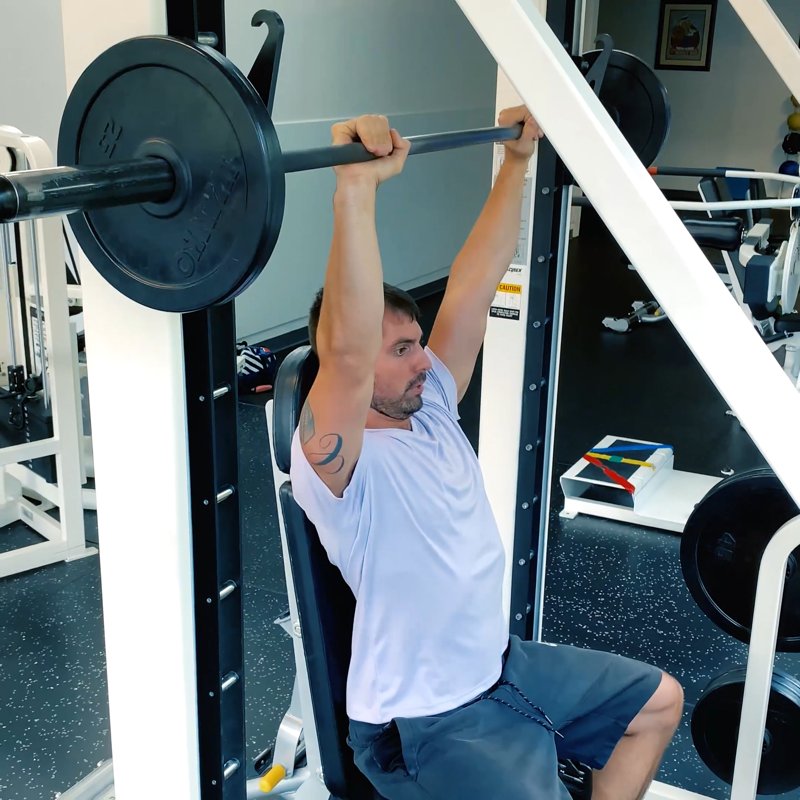
Log in to watch video demonstrations
Login to Watch3 video demonstrations available
Find more video demonstrations in the Gravitus app
Track your progress with Gravitus
Download Gravitus to log your workouts, track your progress, and join a community of fitness enthusiasts.

Helpful Resources
One Rep Max Calculator
Find your one rep max for any exercise without maximal testing. Essential for developing effective strength training programs.
Calculate 1RMWorkout Programs
Follow structured workout programs created by fitness professionals to maximize your strength and muscle gains.
View Programs